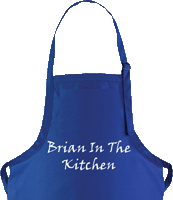Brian in the Kitchen Recipes


BRIAN IN THE KITCHEN brought to you by Stittsworth Meats
June 16 2014
How To Choose A Ham
(from http://virtualweberbullet.com)
Which Ham To Buy?
When choosing a whole, bone-in ham, authors Bruce Aidells and Denis Kelly of The Complete Meat Cookbook write, "A short, plump shape with a stubby rather than an elongated shank is the best choice."
When choosing a half ham, the butt end is meatier and less fatty than the shank end. However, the shank end is easier to carve because of its simple bone structure. Both are good choices, but shank end is preferred.
Natural Juices, Water Added, And Water Product
You'll see references to "juices" or "water" on the label of a ham. Here's how they're defined by the USDA:
Ham: the product is at least 20.5% protein in lean portion and contains no added water. For example, a country ham.
Ham with Natural Juices: the product is at least 18.5% protein. Can weigh 8% more than uncured weight. (This kind of ham should be your first choice for cooking on the WSM. Some spiral-sliced bone-in hams fall into this category.)
Ham—Water Added: the product is at least 17% protein with 10% added solution; it can weigh 8% more after curing than uncured weight. (This is your second best choice for cooking on the WSM. Many supermarket hams and some spiral-sliced hams fall into this category.)
Ham And Water Product: product may contain any amount of water but the label must indicate percent of "added ingredients." For example, "X% of weight is added ingredients" for any canned ham with less than 17% protein.
A ham with more water content will be a less expensive product, but that also means you're paying for a lot of water instead of meat.
Spiral-Sliced Hams
Spiral slicing is a process in which a ham is placed on a special cutting machine that spins the ham around while cutting thin slices all the way to the bone in a continuous spiral. They are usually served with a sweet glaze of some sort. These hams have become extremely popular in recent years because of their serving convenience.
Almost all spiral-sliced hams are bone-in, and some are a "ham with natural juices" product, meaning they're of better quality and flavor. You can buy whole spiral-sliced hams at specialty shops like HoneyBaked Ham, but you're likely to find only half hams at the supermarket or wholesale warehouse store.
Spiral-sliced hams usually include a separate glaze packet. You can use the glaze packet or you can make your own glaze. Ham glaze recipes can be found on the Whole Ham - Mustard & Whiskey Glazed page and the Spiral-Sliced Ham - Sugar Glazed page.
"Ready To Eat" vs. "Ready To Cook"
Most hams that you find at the supermarket are already cooked and can be eaten right out of the package. These include fully-cooked hams, spiral-sliced hams and canned hams. Look for the phrase "ready to eat" on the label.
Fresh hams and hams that have only been partially cooked must be fully cooked to 145-150°F internal temperature so that they achieve a final resting temperature of 155-160°F before serving. Look for the phrase "ready to cook" or "cook before eating" on the label. The USDA safe food handling instructions will also be found somewhere on the label of this kind of ham.
How Much Ham Should I Buy?
Recommendations vary as to how much ham to buy.
HoneyBaked Ham Company offers the following charts:
Half Ham 7-8 lbs 8-9 lbs 9-10 lbs
Dinner Serves: 10-14 14-16 16-18
Buffet Serves: 16-20 21-24 25-28
Whole Ham 12-14 lbs 14-16 lbs 16-18 lbs
Dinner Serves: 22-26 26-30 30-34
Buffet Serves: 33-40 40-45 45-52
Cook's Illustrated estimates that you'll get 3-4 servings per pound of bone-in ham. "Most half hams range in size from 7-10 pounds, serving 20-30."
Martha Stewart says, "A 16-pound ham can feed 18-20 people (estimate about 3/4 pound per person for a bone-in ham and 1/2 pound for boneless)."
Bruce Aidells and Denis Kelly write that a whole ham weighing 10-20 pounds "will serve 20 people, probably with leftovers. A 6-to-8 pound shank (end) will serve 10 to 12 people, a 6-to-8 pound butt (end) 12 or more." They go on to say, "allow 8 to 12 ounces for a bone-in ham per serving, 6 to 8 ounces for a boneless ham."
The USDA recommends 1/4 to 1/3 pound of boneless ham per serving, 1/3 to 1/2 pound of meat per serving of ham with little bone, and 3/4 to 1 pound of meat per serving of ham with large bone.
Serving Temperature
Most people agree that ham should be served warm or cool—but definitely not cold right out of the refrigerator. For a "ready to eat" ham, a range of 110-140° seems to be the consensus. "Ready to cook" hams must be fully cooked to 145-150°F internal temperature so that they achieve a final resting temperature of 155-160°F before serving.